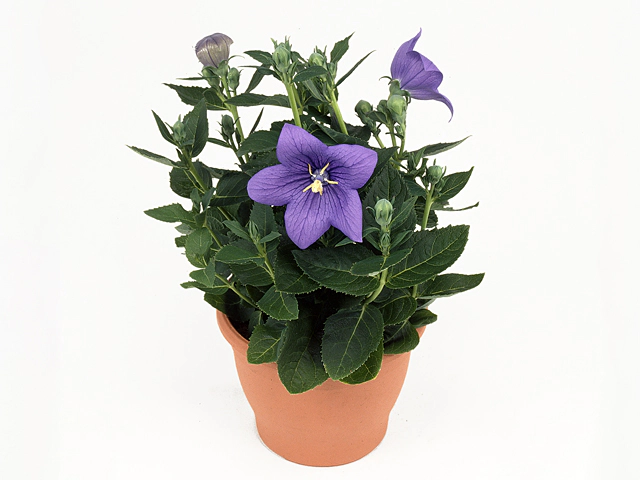Platycodon grandiflorus

| Leaf tip | Blunt/obtuse |
| Fruit type | Capsule |
| Leaf margin | Dentate |
| Leaf type | Foliage leaf |
| Winter hardness | Excellent (USDA-zone 1,2,3,4) |
| Leaf, general shape | Elongate |
| Flower diameter | 8 - 8,5 cm; 8,5 - 9 cm |
| Flower length/hight | 4,5 - 5 cm; 4 - 4,5 cm |
| Inflorescence | Few-flowered; Single-flowered |
| Structure (tissues) | Herbaceous; Subshrubby/semi-shrubby |
| Leaf size | 7,5 - 10 cm |
| Light conditions | Sunny; Semi-shades |
| Leaf division | Simple |
| Leaf, main color | Dark green |
| Toxicity (if consumed) | Not or barely |
| Moisture requirements | Well-drained |
| Soil type | Sandy clay; Sandy |
One of the key features of Platycodon grandiflorus is its foliage. The leaves of this plant are elongate in shape and have a dark green color. The leaf tips are blunt or obtuse, and the leaf margin is dentate, giving them a unique appearance. The leaves are simple in division and have a size of about 7.5 to 10 cm.
During the summer, Platycodon grandiflorus produces stunning balloon-like flowers. The flower diameter can range from 8 to 9 cm, with some variations in size. The flowers can be single or few-flowered and are usually blue or purple in color. They have a length or height of about 4 to 5 cm. The flowers are borne in inflorescences and attract pollinators like bees and butterflies.
Platycodon grandiflorus is an excellent choice for gardens and landscapes. It is known for its winter hardness and can thrive in USDA zones 1, 2, 3, and 4. This means that it can withstand cold temperatures and is suitable for regions with harsh winters. It prefers well-drained soil and can tolerate sandy clay, sandy loam, and clay loam types. The plant can grow well in both sunny and semi-shaded areas, making it versatile in landscaping.
One interesting aspect of Platycodon grandiflorus is its herbaceous and subshrubby/semi-shrubby structure. This means that the plant combines characteristics of both herbaceous and shrubby plants, giving it a unique growth habit. It can reach a height of 30 to 60 cm and has a spread of 20 to 30 cm, making it a compact and manageable plant.
Another important factor to note is that Platycodon grandiflorus is not toxic if consumed. However, it is always recommended to exercise caution and keep plants out of the reach of children and pets.
In its native range, Platycodon grandiflorus has been used for various medicinal purposes. The roots and leaves of the plant are believed to have anti-inflammatory and expectorant properties. They have been traditionally used for treating respiratory ailments, sore throat, and cough. Today, the plant is also cultivated for its ornamental value, adding beauty to gardens and landscapes.
In conclusion, Platycodon grandiflorus, or the balloon flower, is a striking plant known for its beautiful flowers and unique foliage. With its adaptability to different soil types, winter hardiness, and low maintenance requirements, it is a popular choice among gardeners. Whether grown in borders, containers, or mixed flower beds, this perennial plant adds a touch of elegance and charm to any landscape.
Market availability index by month:
| Jan. | Feb. | Mar. | Apr. | May | Jun. | Jul. | Aug. | Sep. | Oct. | Nov. | Dec. |
|---|---|---|---|---|---|---|---|---|---|---|---|
| - | 1 | - | 2 | 4 | 3 | 3 | 4 | 1 | - | - | - |